On a June morning, I struggled my way through the wetland margin of the Laas Tamarack. Wanting to find what breeding bird species resided in this largely inaccessible and otherworldly tamarack bog, the allure of the unknown was soon filled with regret and rubber boots full of murky bog water. This was to be expected.
A brushy tangle of tamaracks and understory. Photo by Drew Harry
Many of the birds I heard and saw were also expected: yellow warblers, robins, gray catbirds, red-winged blackbirds, common yellowthroats, cedar waxwings, chickadees, wood ducks, and a green heron. Delightful, no doubt, but they didn’t include any of the hoped-for birds, like a mourning or Canada warbler, or a white-eyed vireo. The sunrise through the tamaracks, in combination with the morning dew, gave the needles a bluish tinge. Meanwhile I appreciated the treasures of the bog: pink lady’s slippers orchids, unique sedges like cottongrass, and blueberry and huckleberry. Of course, the hummocks of sphagnum moss offered a delightful color palate of red, green, and brown; while also varying the topography so that I had to listen for rare birds instead of also looking for them.
After wandering around the outskirts of the tamaracks and appreciating the sunrise, I stopped and touched a particularly burly young tamarack. From this tree, at about eye level, flushed a good-sized bird that jolted me back from the tree; a moment later I realized it was a black-billed cuckoo, and a moment after that I saw it had flushed from its nest. Here was a delightful find!
The nest defied the warm and homely expectation of care instructions for eggs. Instead, the black-billed cuckoo that I found opted for a few sticks crudely stitched together in the crook of the tamarack. I would not make it back into the tamarack to monitor the nest, but with a frail gust, those eggs could have easily tumbled to the ground.
This type of nest construction is actually typical for black-billed cuckoos. While cuckoo relatives in England will parasitize the nests of other birds, the black-billed is less likely to do so, but still has been known to lay eggs in the nests of other birds. I’d like to think the cuckoo, upon finding the nest of a robin and envious of the cozy design, decides instead to squat its eggs in the more hospitable robin nest.
Cuckoos, more often heard than seen (with their three-noted coo-coo-coo), thrive in brushy and gangly thickets. Where I found this cuckoo nest, I had to cross a wetland edge of a few feet of water, then stumble my way through an almost impossibly thick maze of shrubs and small trees. This is just how the cuckoo likes it.
The beautiful, but intimidating to hikers, tamarack bog. Photo by Drew Harry
Where I’ve encountered cuckoos in thickets, they’ve been hilariously hard to spot. I might excitedly point out the bird to our summer interns, only for the bird to sit still for minutes on end. When it starts moving again, it’s still hard to spot with its brown to olive plumage and namesake black bill, but a white underside and red eye ring reveal flashes of this brilliant bird. I recall one summer when I looked at a black-billed cuckoo with the interns, and the bird seemed to mirror our movements through the brush. Here we were, hunched over and rocking our head every which way, and there went the cuckoo, looking at us, moving quickly in short spurts and navigating the jungle of brush.
Black-billed cuckoo photo by Tom Murray, FCC
During the breeding season, black-billed cuckoos are relatively common throughout Wisconsin. However, indices of population from breeding bird survey routes suggest a steady decline of the cuckoo population in Wisconsin. Since habitat in Wisconsin is sufficient to support this species, it is thought that spraying for gypsy moths might affect food availability, or pesticide spraying may kill caterpillars and thus eliminate an important food source.
Cuckoos love caterpillars, and where you have an outbreak of caterpillars—especially tent caterpillars—you will often find cuckoos. Breeding bird survey data from Wisconsin reflects this element of cuckoo ecology, as the density of black-billed cuckoos is highly variable, and peaks every 8 or 9 years, almost always coinciding with a caterpillar outbreak. One interesting adaptation that black-billed cuckoos have to eating sometimes spiny caterpillars is that they shed their stomach lining, coughing it up in a pellet.
You won’t be able to find any cuckoos right now at Faville Grove, and you’ll likely have to wait until mid to late May to see one, but North Shore Road is a reliable spot to find this secretive bird.
Written by Drew Harry, Faville Grove Sanctuary land steward









